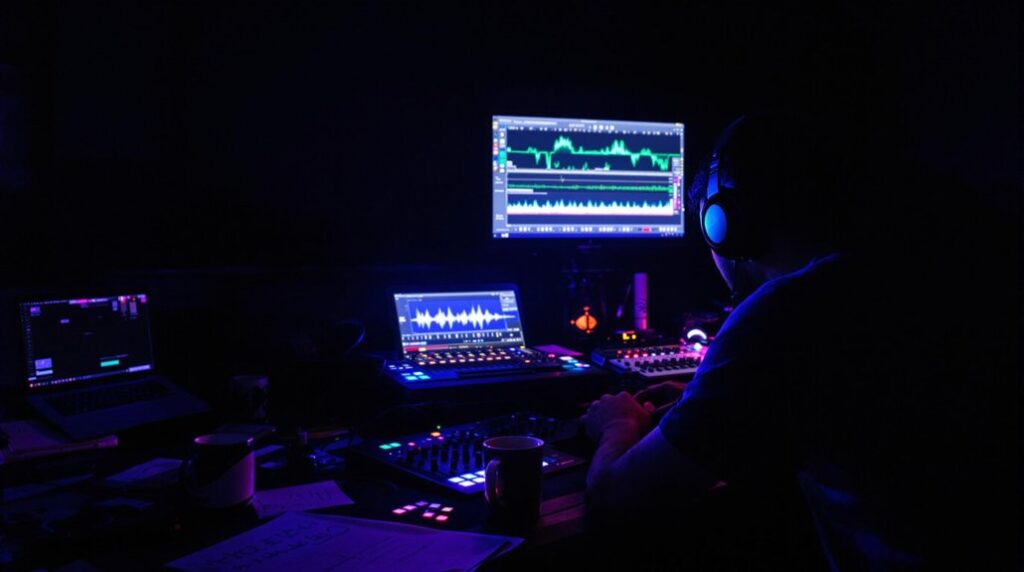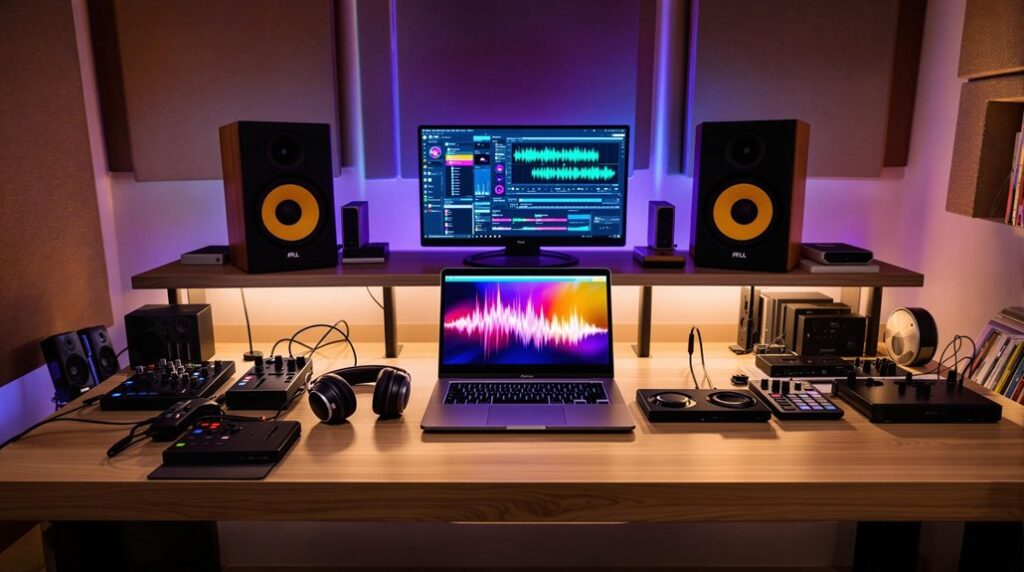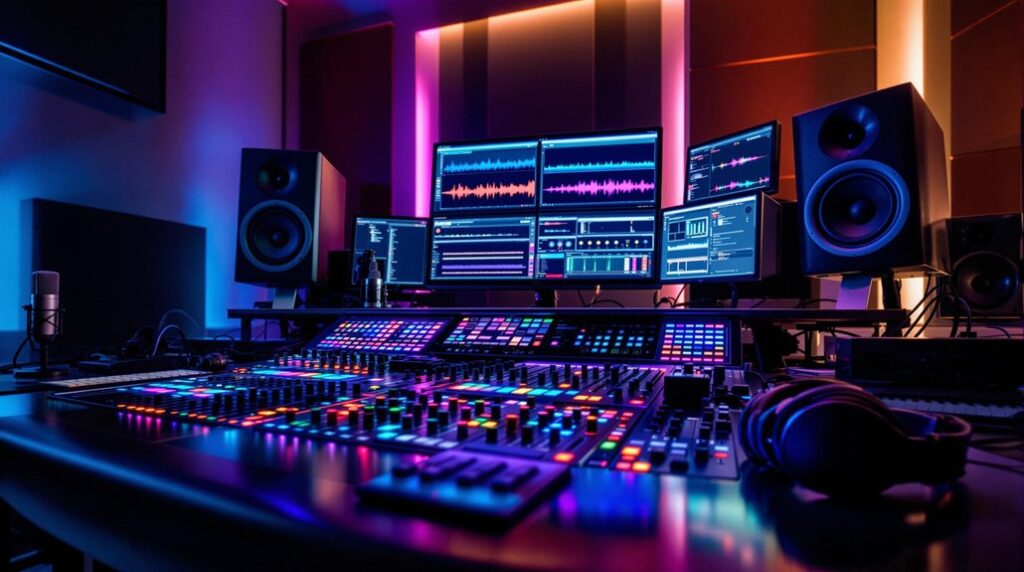Utilizing a MIDI controller can greatly enhance your mixing workflow by providing hands-on control over your DAW’s virtual instruments and automation parameters. You’ll benefit from velocity-sensitive keys, assignable knobs, and customizable mappings, which facilitate precise, real-time adjustments. This reduces reliance on your mouse, offering ergonomic and intuitive navigation throughout your mixing process. Advanced features like aftertouch and arpeggiators further boost creativity and efficiency. Whether you’re using a MIDI keyboard for melodies or pad controllers for beats, the tactile feedback and dedicated controls streamline your tasks. To discover the full spectrum of capabilities, there’s much more to explore.
Key Takeaways
- Customizable mappings allow precise control over DAW functions, streamlining the mixing workflow.
- Programmable buttons enable quick access to frequently used functions, enhancing efficiency.
- Transport controls simplify playback, recording, and navigation, reducing reliance on the mouse.
- Tactile feedback from ergonomic designs improves user experience and intuitive adjustments.
- Real-time parameter adjustments facilitate dynamic and nuanced mixing, boosting creativity and precision.
Understanding MIDI Controllers
MIDI controllers are essential hardware devices that transmit MIDI data, enabling precise control over virtual instruments, effects, and parameters in your digital audio workstation (DAW).
Understanding MIDI controller features is important for optimizing your music production workflow. These features include velocity-sensitive keys, assignable knobs, faders, and pads, which allow you to execute Note-On, Note-Off, Control Change, and Program Change messages with pinpoint accuracy.
To maximize the utility of your MIDI controller, a proper MIDI controller setup is necessary. Start by connecting your controller to your computer via USB or MIDI interface. Make sure your DAW recognizes the device and map the controls to the desired parameters. For example, assign faders to volume controls, knobs to filter cutoffs, and pads to drum triggers.
This setup process involves customizing MIDI mappings to suit your specific workflow, ensuring seamless integration and real-time manipulation.
Additionally, advanced MIDI controllers may offer features like aftertouch, transport controls, and built-in arpeggiators, enhancing your ability to perform complex musical tasks.
Benefits of MIDI Controllers
By incorporating tactile feedback and dedicated hardware controls, MIDI controllers greatly enhance your mixing workflow, offering unparalleled precision and efficiency.
The tactile feedback you receive from these devices allows for precise adjustments, ensuring that every tweak to your mix is intentional and accurate. This hands-on approach translates to significant performance improvements, as you can execute complex tasks with greater speed and reduced error.
The ergonomic design of MIDI controllers is another key benefit. These devices are crafted with user comfort in mind, reducing strain during extended mixing sessions. Ergonomically placed knobs, sliders, and buttons allow for intuitive navigation, making it easier to access frequently used functions without disrupting your creative flow.
Workflow enhancements are perhaps the most significant advantage. MIDI controllers streamline your Digital Audio Workstation (DAW) tasks by providing direct access to various parameters. This eliminates the need for constant mouse and keyboard usage, allowing for a more fluid and efficient workflow.
Tactile feedback ensures that you can make real-time adjustments to your effects and instruments, enabling a more dynamic and responsive mixing process. Ultimately, the integration of MIDI controllers into your setup results in a more efficient, precise, and enjoyable mixing experience.
Types of MIDI Controllers
Understanding the various types of MIDI controllers is essential for optimizing your music production workflow, as each offers unique features tailored to specific needs. MIDI keyboards are equipped with piano or synth-style keys, making them ideal for composing melodies, harmonies, and complex chord progressions. They provide tactile feedback and velocity sensitivity, which are important for expressive performance and nuanced dynamics.
In contrast, pad controllers feature touch-sensitive pads designed for triggering drum samples, loops, and one-shot sounds. The tactile nature of these pads allows for rapid, rhythmic input, making them indispensable for beat-making and live performance scenarios. When comparing a MIDI keyboard vs. pad controller, the choice hinges on whether your priority is melodic composition or rhythmic execution.
Additionally, some advanced MIDI controllers, like the CMPSR, incorporate joystick input advantages. Joysticks offer multidimensional control, enabling you to manipulate multiple parameters simultaneously, such as pitch and modulation, with a single gesture. This feature can greatly enhance your expressive capabilities, allowing for more dynamic and intricate sound design.
Choosing the right MIDI instrument involves understanding how it aligns with your music production style and goals. Whether you’re focusing on melodic content or intricate rhythms, the right controller can profoundly impact your creative workflow.
Integrating MIDI With DAWS
When you integrate MIDI controllers with DAWs, you simplify track automation, making it easier to manage complex sessions.
Customizable control mapping lets you assign specific functions to your controller, ensuring intuitive access to essential parameters.
Real-time parameter adjustments provide immediate feedback, allowing for precise tweaks and a more efficient mixing process.
Simplifying Track Automation
Integrating MIDI controllers with your DAW’s automation lanes allows for precise, real-time control over volume, panning, and effects, streamlining your mixing process. By leveraging automated dynamics and MIDI versatility, you can achieve nuanced adjustments that enhance your mix’s overall quality.
MIDI integration with industry-standard DAWs like Ableton Live, Logic Pro, and Pro Tools offers seamless control over automation parameters, enabling you to create intricate, expressive changes with ease.
Setting up MIDI controllers for track automation involves mapping specific controller elements—such as faders, knobs, and buttons—to corresponding parameters within your DAW’s automation lanes. This mapping process guarantees that each physical control on your MIDI device directly influences the desired aspect of your track, allowing for streamlined workflows and tactile precision in your mixing.
Real-time adjustments using MIDI controllers greatly improve the dynamic range and expression of your automated tracks. This capability allows for more natural-sounding volume swells, precise panning movements, and detailed effects automation, which collectively contribute to a polished, professional mix.
Customizable Control Mapping
Customizable control mapping lets you assign specific MIDI controller functions to precise parameters within your DAW, ensuring a tailored and efficient mixing workflow. By utilizing advanced mapping techniques, you can link knobs, faders, and buttons on your MIDI controller to control EQ, volume, panning, and various effects with pinpoint accuracy. This flexibility caters to user preferences, allowing you to create a highly personalized setup that fits your unique mixing style.
Customization options abound, enabling you to configure custom mappings for different tracks, plugins, and virtual instruments. This means you can switch between controlling a drum track to tweaking a vocal reverb with ease. Mapping techniques such as MIDI Learn simplify the process, letting you assign controls by simply moving a parameter within your DAW while manipulating the corresponding controller element.
Workflow optimization is one of the most significant benefits of customizable control mapping. Quick access to essential mixing controls reduces the time spent browsing through software menus, allowing you to focus more on the creative aspects of mixing. Integrating MIDI controllers with DAWs through custom mapping opens up endless possibilities, enabling you to implement innovative and efficient mixing strategies tailored to your specific needs.
Real-time Parameter Adjustments
Mastering real-time parameter adjustments with MIDI controllers in your DAW significantly enhances your ability to make precise, tactile tweaks to volume, panning, and effects during mixing sessions. By integrating MIDI controllers, you can manipulate these parameters dynamically, providing a level of control that mouse and keyboard operations simply can’t match. This tactile interface allows for swift, intuitive adjustments that are vital during live performances and intricate mixing tasks.
Your DAW recognizes MIDI inputs, converting physical movements into digital commands. This means you can seamlessly control virtual instruments and plugins, making your workflow more efficient and creative. For instance, you can adjust an EQ filter’s cutoff frequency or modulate reverb depth in real-time, ensuring that each tweak perfectly fits the mix’s context.
MIDI controllers streamline the mixing process, offering hands-on control over essential parameters. Instead of navigating through multiple software menus, you can make dynamic adjustments on-the-fly, enhancing both your efficiency and creativity. This real-time interaction not only speeds up your workflow but also allows for a more expressive and responsive mixing experience, making it indispensable for both studio and live performance scenarios.
Tactile Control Advantages
Tactile control with MIDI controllers greatly enhances your mixing workflow by providing precise adjustments for parameters such as volume, panning, and effects. Leveraging the ergonomic design and tactile feedback of physical knobs, faders, and buttons, you can achieve a hands-on approach that notably improves user experience and workflow optimization.
This tangible interaction allows for intuitive real-time adjustments, making your mixing process more dynamic and engaging.
Consider the following advantages:
- Ergonomic Design: The physical layout of MIDI controllers is designed to reduce strain, allowing for longer mixing sessions without causing repetitive strain injuries.
- Tactile Feedback: The immediate response you get from knobs and faders provides a more natural and intuitive way to make adjustments, enhancing precision and control.
- User Experience: The tactile nature of these controllers simplifies complex tasks, streamlining your workflow and making the mixing process more enjoyable.
Improved Workflow Efficiency
Integrating MIDI controllers into your digital audio workstation (DAW) drastically accelerates routine mixing tasks by offering direct, hands-on control over essential parameters like volume, panning, and effects. With time-saving features such as dedicated faders, knobs, and buttons, you can swiftly adjust multiple tracks simultaneously, eliminating the need for repetitive mouse clicks and menu navigation.
This tactile interface not only enhances workflow optimization but also reduces cognitive load, allowing you to focus more on creative aspects rather than technical minutiae.
MIDI controllers provide ergonomic advantages by placing frequently used controls within easy reach, thereby streamlining your workflow. For instance, transport functions such as play, stop, and record can be executed via physical buttons on the controller, offering immediate response and precise timing adjustments. Channel strips on MIDI controllers enable real-time manipulation of track parameters, facilitating efficient mix adjustments without interrupting your creative flow.
Moreover, automation becomes far more intuitive with MIDI controllers, as you can dynamically alter effects and levels with physical movements, capturing more natural-sounding shifts. The integration of these time-saving features into your DAW not only optimizes your workflow but also empowers you to achieve professional-quality mixes with greater ease and speed.
Precision in Mixing
Leveraging the ergonomic advantages of MIDI controllers, you’ll achieve unparalleled precision in mixing, enabling meticulous control over parameters like volume, panning, and effects. This mixing accuracy is crucial for creating a polished final product.
The tactile feedback offered by these controllers allows you to make real-time adjustments effortlessly, enhancing your workflow to a great extent.
Using a MIDI controller, you can fine-tune automation curves, providing expressive automation that adds a layer of nuanced control to your mix. The tactile interface ensures that every subtle adjustment is both felt and heard, making the mixing process more intuitive and responsive.
- Volume Control: Adjust faders with pinpoint accuracy, ensuring balanced levels across your mix.
- Panning Precision: Manipulate panning knobs to create a spatially immersive audio experience.
- Effects Manipulation: Tweak effects parameters in real-time, allowing for dynamic and responsive sound design.
With these tools at your fingertips, you can achieve a level of detail and finesse that would be challenging to replicate with a mouse and keyboard alone. MIDI controllers empower you to deliver mixes that are both technically superior and artistically expressive, transforming your audio production into a refined masterpiece.
MIDI Automation Techniques
Harnessing the power of MIDI automation techniques, you can intricately control various parameters such as volume, panning, and effects within your DAW to add dynamic changes and nuanced movements to your music. By recording and editing MIDI automation data, you achieve advanced modulation and detailed expression, guaranteeing each musical element evolves precisely as intended.
Whether you’re automating a virtual instrument, an effects plugin, or a hardware synthesizer, MIDI automation integrates seamlessly into your workflow, allowing for dynamic shifts that breathe life into your tracks.
Using a MIDI controller, you can fine-tune automation curves and patterns in real-time, offering a tactile, intuitive approach to shaping your sound. Adjusting parameters like filter cutoff, resonance, or reverb decay directly from your controller provides a hands-on experience that translates into more organic and fluid automation data. This capability is vital for achieving the level of detailed expression needed in professional music production.
Moreover, MIDI automation’s precise control ensures that every modulation and adjustment is executed flawlessly, elevating your mix to new heights. By mastering these techniques, you equip yourself with the tools to create intricate, dynamic, and polished musical productions.
Enhancing Creativity
MIDI controllers offer unparalleled interactivity and tactile feedback, enabling you to experiment with musical ideas and enhance your creative workflow. By providing direct access to your DAW’s functions, they invite innovative experimentation and foster creative inspiration. The precision and control of MIDI instruments allow for nuanced musical expression and dynamic exploration, making every performance more engaging.
Hands-on manipulation of knobs, faders, and pads gives you precise control over virtual instruments and effects, allowing for intricate adjustments that mouse and keyboard setups can’t match.
Dynamic Exploration: MIDI controllers enable real-time modulation of parameters such as filter sweeps, pitch bends, and velocity sensitivity, which adds depth and dynamism to your compositions.
Streamlined Workflow: Integrating MIDI controllers into your setup streamlines everyday tasks in recording, editing, and arranging, making it easier to capture spontaneous ideas and maintain creative momentum.
Selecting the Right Controller
As you seek to enhance your creative workflow, selecting the right controller involves evaluating the specific types of tactile controls—knobs, faders, pads, or keys—that best suit your mixing needs. Begin by considering controller ergonomics; the layout and size should fit comfortably within your workspace, ensuring ease of use during extended sessions.
Motorized faders are particularly advantageous for precise automation, providing tactile feedback that allows for more intuitive adjustments.
Compatibility considerations are paramount. Make sure your chosen controller integrates seamlessly with your Digital Audio Workstation (DAW). This integration facilitates efficient workflow and prevents technical hiccups that could disrupt your creative process.
Look for controllers that offer customizable mappings and programmable buttons, as these features can greatly enhance your mixing experience by allowing you to tailor the controller to your specific workflow.
Additional features like transport controls can streamline your process, enabling you to manage playback, recording, and navigation without relying on your computer keyboard.
Frequently Asked Questions
What MIDI Controller Works Best With Reason?
You’ll find that the M Audio Code and Akai MPK seamlessly integrate with Reason. The M Audio Code offers expansive control with velocity-sensitive pads, while the Akai MPK’s compact design and assignable controls guarantee precise, hands-on mixing.
What MIDI Controllers Do Producers Use?
You’ll find producers using popular models like the Akai MPK Mini and Novation Launchpad. For budget options, consider the Arturia MiniLab or M-Audio Keystation, as they offer essential features without compromising functionality or performance quality.
What Can a MIDI Controller Do?
A MIDI controller lets you manipulate virtual instruments and automation control in your DAW. You can send Note-On, Note-Off, and Control Change messages, providing tactile feedback for precise parameter adjustments and real-time control over your production.
Can You Use 2 MIDI Controllers at Once?
Yes, you can use multiple devices simultaneously to enhance workflow efficiency. Assign distinct functions to each MIDI controller; employ one for melodies and another for effects manipulation. Most DAWs support this multi-controller setup, optimizing your mixing process.
Conclusion
By integrating MIDI controllers into your mixing workflow, you’ll gain tactile control, heightened precision, and seamless DAW integration.
These devices not only streamline your mixing process but also enhance creative potential through advanced automation techniques.
When selecting the right controller, consider your specific needs and workflow preferences.
Embracing MIDI controllers can greatly improve your productivity and enhance your mixing projects to professional standards.
Don’t miss out on the transformational benefits they offer.




